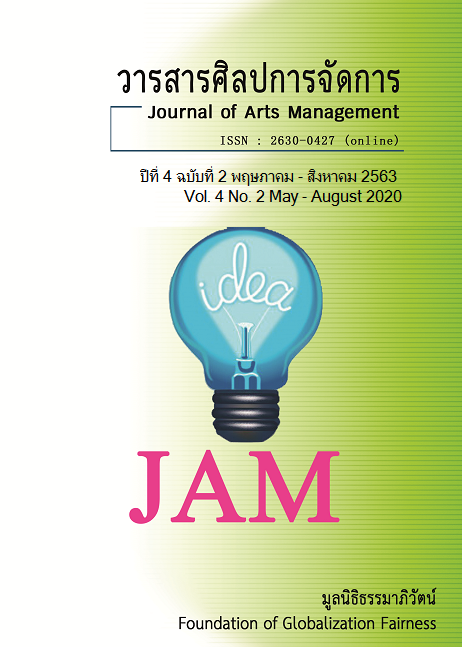The Use of Creative Media for Undergraduate Students in Bangkok
Main Article Content
Abstract
The objective of this research were 1) to study behavior of cyberbully, 2) to study the level of the effects of cyberbully, and 3) to propose creative ways of using media for undergraduate students in Bangkok. Population and sample groups were 1) 400 undergraduate students who living in Bangkok and 2) 5 Communication arts experts. The research instruments were questionnaires and in-depth interviews. The quantitative data analyzed with quantity and percentage and the qualitative data analyzed with a summary interpretation. The results of the research revealed that 1) The most cyberbully behavior is arguing with others over the telephone/social media using violent words that accounting for 71.3 percent 2) The most effects of cyberbully is cyberbully causes suicidal bully that accounting for 47.2 percent 3) Guidelines for using creative media for undergraduate students in Bangkok Consists of 5 issues consisting of 1) Creating knowledge on online media use regularly 2) Studying and monitoring the changes of online media all the time 3) Building immunity for using online media for yourself 4) Creating skills for knowing online media in the dimension, and 5) Create thinking processes, analyze, differentiate information.
Article Details
Views and opinions appearing in articles in the Journal of Arts of Management It is the responsibility of the author of the article. and does not constitute the view and responsibility of the editorial team I agree that the article is copyright of the Arts and Management Journal.
References
นภาวรรณ อาชาเพ็ชร. (2560). การรังแกผ่านโลกไซเบอร์ ความรุนแรงที่ต้องแก้ไขและนวัตกรรมการจัดการปัญหา. วารสารวิชาการนวัตกรรมสื่อสารสังคม, 5(1), 100-106.
เบญจมาศ พลอินทร์. (2524). วรรณคดีขนบประเพณีและศาสนา. กรุงเทพฯ: ภาพพิมพ์.
ฤทัยชนนี สิทธิชัย และ ธันยากร ตุดเกื้อ. (2560). พฤติกรรมการรังแกบนโลกไซเบอร์ของเยาวชนในสามจังหวัดชายแดนใต้. วารสารวิทยบริการ มหาวิทยาลัยสงขลานครินทร์, 28(1), 86.
วิทยา ดำรงเกียรติศักดิ์. (2558). การข่มเหงกักขฬะออนไลน์. สืบค้นเมื่อ 20 มกราคม 2563. จาก http://www.infocommmju.com/icarticle/images/stories/icarticles/ajwittaya/digital/cyberbullying2.pdf.
สมบูรณ์ สุริยวงศ์, สมจิตรา เรืองศรี และ เพ็ญศรี เศรษฐวงศ์. (2544). ระเบียบวิธีวิจัยทางการศึกษา. พิมพ์ครั้งที่ 2. กรุงเทพฯ: โรงพิมพ์ศูนย์ส่งเสริมวิชาการ.
สรานนท์ อินทนนท์ และ พลินี เสริมสินสิริ. (2561). การศึกษาวิธีการป้องกันการกลั่นแกล้งบนโลกของไซเบอร์ของวัยรุ่น สถาบันสื่อเด็กและเยาวชน. สืบค้นเมื่อ 20 มิถุนายน 2562. จาก http://eprints.utcc.ac.th.
สุภาวดี เจริญวานิช. (2560). การรังแกกันผ่านพื้นที่ไซเบอร์: ผลกระทบและการป้องกันในวัยรุ่น. วารสารวิทยาศาสตร์และเทคโนโลยี, 25(4), 639-648.
สุรพงษ์ โสธนะเสถียร. (2533). การสื่อสารกับสังคม คณะวารสารศาสตร์และสื่อสารมวลชน มหาวิทยาลัยธรรมศาสตร์. กรุงเทพฯ: สำนักพิมพ์จุฬาลงกรณ์มหาวิทยาลัย.
อวยพร เขื่อนแก้ว. (2555). วัฒนธรรมชายเป็นใหญ่. สืบค้นเมื่อ 20 มิถุนายน 2562. จาก http://muslimchiangmai.net/index.php?topic=77230.
Cyberbullying Research Center. (2015). Cyberbullying Data. สืบค้นเมื่อ 20 มิถุนายน 2562. จาก http;//cyberbullying.org/2015-data.
Fowler, D. (2016). Back to school-let’s keep our kids safe online. สืบค้นเมื่อ 20 มิถุนายน 2562. จาก https://www.act-on.com/blg/back-to-school-lets-keep-our-kids-safe-online.
Fuzion Communication. (2013). Cyber bullying awareness campaign shortlisted for prestigious National PRII Award. สืบค้นเมื่อ 20 มิถุนายน 2562. จาก http://www.fuzion.ie/news/id/795.
Kaspersky Lab. (2015). 10 forms of cyberbullying. สืบค้นเมื่อ 20 มิถุนายน 2562. จาก https://kids. kaspersky.com/10-forms-of-cyberbullying
Lazarus, R., and Folkman, S. (1984). Stress, appraisal, and coping. New York: Springer.


